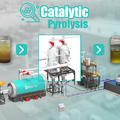In the landscape of waste management, pyrolysis technology emerges as a game-changer, revolutionizing the recycling of industrial hazardous waste. This article delves into the transformative potential of pyrolysis plants, exploring how they bring about technological changes in the treatment of hazardous waste streams.
Understanding Pyrolysis Technology
Operational Principles
Pyrolysis technology operates on the principle of thermal decomposition, wherein organic materials are subjected to high temperatures in the absence of oxygen. This process leads to the breakdown of complex molecules into simpler compounds, producing valuable end products such as biochar, syngas, and bio-oil.
Versatility and Flexibility
Pyrolysis plants are highly versatile and adaptable, capable of processing a wide range of feedstocks, including plastics, rubber, biomass, and hazardous waste. This flexibility allows for the efficient treatment of diverse waste streams, maximizing resource recovery and minimizing environmental impact.
Transforming Hazardous Waste Recycling
Waste Minimization
One of the key benefits of pyrolysis technology in hazardous waste recycling is waste minimization. By converting hazardous materials into valuable products, such as biochar and syngas, pyrolysis plants reduce the volume of waste destined for landfill or incineration, mitigating environmental pollution and conserving valuable resources.
Resource Recovery
Pyrolysis plants facilitate resource recovery from hazardous waste streams, extracting valuable materials and energy-rich products for reuse or recycling. This not only reduces the need for virgin materials but also creates new revenue streams from the sale of recovered products, enhancing the economic viability of waste recycling operations.

Advantages of Pyrolysis Technology
Environmental Sustainability
Pyrolysis technology promotes environmental sustainability by minimizing greenhouse gas emissions and reducing reliance on fossil fuels. The conversion of hazardous waste into biochar and syngas helps mitigate climate change and air pollution, contributing to a cleaner and healthier environment.
Energy Efficiency
Pyrolysis plants are inherently energy-efficient, utilizing waste-derived heat to sustain the pyrolysis process. This closed-loop system maximizes energy recovery and minimizes external energy inputs, resulting in lower operational costs and a reduced carbon footprint.
Circular Economy
By closing the loop on waste management, pyrolysis technology fosters a circular economy model wherein resources are continually recycled and reused. This paradigm shift towards resource efficiency and sustainability promotes long-term environmental stewardship and economic resilience.
Applications of Pyrolysis Technology
Hazardous Waste Management
Pyrolysis plants play a crucial role in the management of hazardous waste, offering a safe and sustainable alternative to landfilling and incineration. By converting hazardous materials into inert biochar and clean syngas, pyrolysis technology minimizes environmental risks and protects human health.
Chemical Recycling
Chemical recycling, facilitated by pyrolysis technology, enables the recovery of valuable chemicals and polymers from mixed plastic waste. This innovative approach to plastics recycling helps address the global plastic pollution crisis while creating opportunities for the circular economy.
Future Directions and Challenges
Technological Advancements
The ongoing development of pyrolysis technology holds promise for further improvements in efficiency, product quality, and process optimization. Advancements in reactor design, catalyst development, and process control systems will drive innovation and expand the applicability of pyrolysis plant for sale in hazardous waste recycling.
Regulatory Compliance
Challenges remain in ensuring regulatory compliance and public acceptance of pyrolysis plants for hazardous waste recycling. Stringent environmental regulations and community engagement efforts are essential to address concerns regarding emissions, waste handling, and health and safety risks associated with pyrolysis technology.
Conclusion
In conclusion, pyrolysis technology represents a paradigm shift in industrial hazardous waste recycling, offering a sustainable and environmentally responsible alternative to traditional waste management practices. Through the utilization of pyrolysis plants, hazardous waste streams are transformed into valuable resources, promoting circular economy principles and driving technological changes in the waste management industry.





